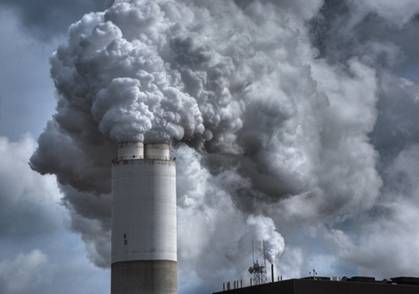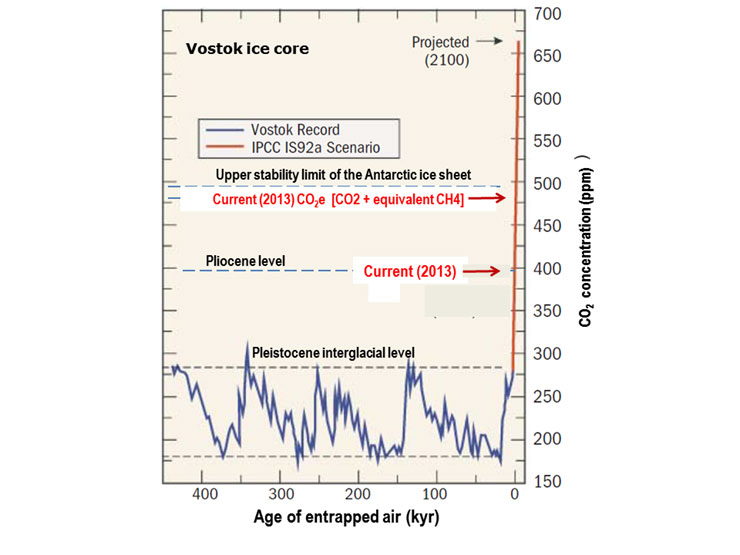CO2: The “Invisible Substance”
By Dr Andrew Glikson
19 July, 2013
Countercurrents.org

Figure 1 - Carbon pollution: not so invisible
For the last 10 years or so George Orwell's dictum “ those who control the present, control the past and those who control the past control the future ” [1] has been expressed through a small number of people, arguing against long-established basic laws of physics, the principles of climate science and current measurements.
According to the leader of the Australian opposition “ It's a market, a so-called market, in the non-delivery of an invisible substance to no one " [2].
But perhaps no so invisible? (see Figure 1).
Given major media platforms, the anti-science lobby has (continues to) provide polluting interests and their political mouthpieces with pseudo-scientific excuses allowing an increase carbon emission and lulling populations to a false sense of security (see: Merchants of doubt [3]).
The consequences are upon humanity and nature:
• CO2 levels have reached record levels of 400 ppm exceeding those of the Pliocene (2.6-5.2 million years ago) within less than a couple of centuries, at an unprecedented rate of 2-3 ppm/year [4] (Figure 2).
• Since the 19 th century global warming has reached 1.5 degrees Celsius above pre-industrial temperatures on the continents [5]. Mean temperature higher than 2 degrees Celsius are masked by sulphur aerosols, which already constitute an unintended global geo-engineering measure [6]. Ocean temperatures to 100 meters depth have risen by ~0.4 degrees C [7], which has already resulted in melting of the Arctic summer ice (12.6 to 11 million square kilometer between June 1979 to 2013 [8]) and is driving melting of the Antarctic ice sheet [9].
• Consequent on the rising CO2 levels ocean acidity has increased by approximately -0.1 pH points [10], placing plankton and corals at risk.
• Consistent with rising temperatures in the oceans, increased evaporation and consequent precipitation lead to floods and increased heat/energy results in the intensification of hurricanes [11].
• Rising temperatures over continents have already resulted in increase in heat waves and fires [12], Australia being no exception [13].
Not that the above features too much in the Australian elections, where the reality of climate change has been replaced with the hit-pocket-nerve term “carbon tax”, “emission trading scheme” or “direct action”. In the context of the fast deteriorating global climate, plans by both major parties of 5 percent reduction in emissions relative to 2000 represent no more than climate window dressing.
Nor are coal exports mentioned too often, despite current exports and planned future exports of representing carbon emissions tracking toward an order of magnitude higher than local emissions [14].
According to Dr Adam Lucas of the Science & Technology Studies Program, University of Wollongong , currently Australia (with ~0.3% of the global population) contributes domestic emissions of about 1.8% of global emissions [15]. The total domestic and overseas consumption of Australian coal is responsible for more than 2% of global emissions. Plans to triple or even quadruple coal export volumes over next 10 years would raise Australia's total contribution to global GHG emissions to around 9% to 11% by 2020 [15].
Which places the “ Great moral challenge of our generation ” [16] in perspective.

Fig. 2. Growth in CO2 and CO2 equivalent (CO2+CH4) during the Pleistocene and the Holocene.
[1] http://www.brainyquote.com/quotes/quotes/g/georgeorwe109402.html
[3] http://www.amazon.com/Merchants-Doubt-Handful-Scientists-Obscured/dp/1608193942
[4] http://www.esrl.noaa.gov/gmd/ccgg/trends/
[5] http://berkeleyearth.org/results-summary/
[6] http://www.atmos-chem-phys.net/11/13421/2011/acp-11-13421-2011.pdf
[7] http://www.nodc.noaa.gov/OC5/3M_HEAT_CONTENT/ ; http://www.nodc.noaa.gov/OC5/3M_HEAT_CONTENT/index3.html
[8] http://nsidc.org/arcticseaicenews/files/2013/07/Figure3.png
[9] http://www.nasa.gov/topics/earth/features/earth20130613.html
[11] http://www.sciencemag.org/content/279/5353/1018.short
[13] http://www.abc.net.au/news/2013-01-19/saturday-bushfire-live-coverage/4472026
[14] http://theconversation.com/on-arctic-sea-ice-melt-and-coal-mine-canaries-5967
[16] http://www.youtube.com/watch?v=CqZvpRjGtGM
Dr Andrew Glikson
Earth and Paleo-climate science
Affiliations:
ANU School of Anthropology and Archaeology,
ANU Planetary Science Institute,
ANU Climate Change Institute,
Honorary Professor, Geothermal Energy Centre of Excellence
The University of Queensland
E-mail: W [email protected]
H [email protected]
http://cci.anu.edu.au/researchers/view/andrew_glikson/
http://archanth.anu.edu.au/staff/dr-andrew-glikson
http://www.mso.anu.edu.au/PSI/PSI_People.html
Comments are moderated


